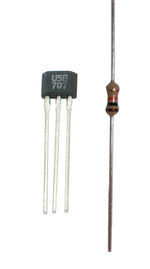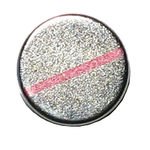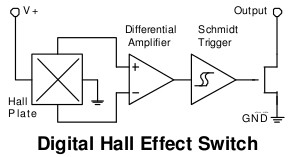Différences entre versions de « Senseur à Effet Hall »
| Ligne 9 : | Ligne 9 : | ||
[[Fichier:HallEffect.jpg|150px]] | [[Fichier:HallEffect.jpg|150px]] | ||
| − | + | [[Fichier:Aimant-Rare-Earth.jpg|150px]] | |
=== Comment cela fonctionne === | === Comment cela fonctionne === | ||
| Ligne 15 : | Ligne 15 : | ||
[[Fichier:TheHallEffect.jpg]] | [[Fichier:TheHallEffect.jpg]] | ||
| − | [[Fichier: | + | La tension de Hall peut être calculée comme VHall = σB où |
| + | * VHall = Champ Electro Magnétique en volts | ||
| + | * σ= Sensibilité en Volts/Gauss | ||
| + | * B= Le champ magnétique appliqué en Gauss | ||
| + | * I= Courant induit (bias current) | ||
| + | |||
| + | Initialement la première utilisation de cette découverte fût axée sur la classification périodique des éléments chimiques. Le développement des semi-conducteurs indium arsenic en 1950 à conduit à la création des premiers instruments à effet Hall utiles. Les senseurs à effet Hall permettait de mesurer des champs magnétiques continu ou static mais nécessitaient que le senseur soit en mouvement. En 1960 la popularisation des semi-conducteurs silicon conduisit à la création des premiers composants combinant un capteur à Effet Hall et un amplificateur opérationnel. Cela produisit ce qui nous appelons classiquement aujourd'hui un Switch Effet Hall à sortie digital (digital output Hall switch). | ||
| + | |||
| + | [[Fichier:HallEffectSwitch.jpg]] | ||
| + | |||
| + | |||
| + | The continuing evolution of Hall transducers technology saw a progression from single element devices to dual | ||
| + | orthogonally arranged elements. This was done to minimize offsets at the Hall voltage terminals. The next pro- | ||
| + | gression brought on the quadratic of 4 element transducers. These used 4 elements orthogonally arranged in a | ||
| + | bridge configuration. All of these silicon sensors were built from bipolar junction semiconductor processes. A | ||
| + | switch to CMOS processes allowed the implementation of chopper stabilization to the amplifier portion of the | ||
| + | circuit. This helped reduce errors by reducing the input offset errors at the op amp. All errors in the circuit non | ||
| + | chopper stabilized circuit result in errors of switch point for the digital or offset and gain errors in the linear out- | ||
| + | put sensors. The current generation of CMOS Hall sensors also include, a scheme that actively switched the | ||
| + | direction of current through the Hall elements. This scheme eliminates the offset errors typical of semiconduc- | ||
| + | tor Hall elements. It also actively compensates for temperature and strain induced offset errors. The overall | ||
| + | effect of active plate switching and chopper stabilization yields Hall-Effect sensors with an order of magnitude | ||
| + | improvement in drift of switch points or gain and offset errors. | ||
| + | Melexis uses the CMOS process exclusively, for best performance and smallest chip size. The developments to | ||
| + | Hall-Effect sensor technology can be credited mostly to the integration of sophisticated signal conditioning cir- | ||
| + | cuits to the Hall IC. Recently Melexis introduced the world’s first programmable linear Hall IC, which offered | ||
| + | a glimpse of future technology. Future sensors will programmable and have integrated microcontroller cores to | ||
| + | make an even “smarter” sensor. | ||
== Montage == | == Montage == | ||
Version du 2 juin 2012 à 19:07
|
|
En cours de traduction |
Introduction
Les senseurs à Effet Hall permettent de détecter si un aimant est a proximité. Ils sont très utiles pour constituer un senseur SANS contact et résistant à l'eau. Ils peuvent aussi servir comme senseur de position, encodeur, détection de rotation.
Parmi les nombreux senseurs à effet Hall disponibles sur le marché, l'un des meilleurs est certainement le US5881LUA.
Comment cela fonctionne
La tension de Hall peut être calculée comme VHall = σB où
- VHall = Champ Electro Magnétique en volts
- σ= Sensibilité en Volts/Gauss
- B= Le champ magnétique appliqué en Gauss
- I= Courant induit (bias current)
Initialement la première utilisation de cette découverte fût axée sur la classification périodique des éléments chimiques. Le développement des semi-conducteurs indium arsenic en 1950 à conduit à la création des premiers instruments à effet Hall utiles. Les senseurs à effet Hall permettait de mesurer des champs magnétiques continu ou static mais nécessitaient que le senseur soit en mouvement. En 1960 la popularisation des semi-conducteurs silicon conduisit à la création des premiers composants combinant un capteur à Effet Hall et un amplificateur opérationnel. Cela produisit ce qui nous appelons classiquement aujourd'hui un Switch Effet Hall à sortie digital (digital output Hall switch).
The continuing evolution of Hall transducers technology saw a progression from single element devices to dual
orthogonally arranged elements. This was done to minimize offsets at the Hall voltage terminals. The next pro-
gression brought on the quadratic of 4 element transducers. These used 4 elements orthogonally arranged in a
bridge configuration. All of these silicon sensors were built from bipolar junction semiconductor processes. A
switch to CMOS processes allowed the implementation of chopper stabilization to the amplifier portion of the
circuit. This helped reduce errors by reducing the input offset errors at the op amp. All errors in the circuit non
chopper stabilized circuit result in errors of switch point for the digital or offset and gain errors in the linear out-
put sensors. The current generation of CMOS Hall sensors also include, a scheme that actively switched the
direction of current through the Hall elements. This scheme eliminates the offset errors typical of semiconduc-
tor Hall elements. It also actively compensates for temperature and strain induced offset errors. The overall
effect of active plate switching and chopper stabilization yields Hall-Effect sensors with an order of magnitude
improvement in drift of switch points or gain and offset errors.
Melexis uses the CMOS process exclusively, for best performance and smallest chip size. The developments to
Hall-Effect sensor technology can be credited mostly to the integration of sophisticated signal conditioning cir-
cuits to the Hall IC. Recently Melexis introduced the world’s first programmable linear Hall IC, which offered
a glimpse of future technology. Future sensors will programmable and have integrated microcontroller cores to
make an even “smarter” sensor.
Montage
Les montages présentés sur cette page sont basé sur le senseur Effet Hall US5881LUA disponible chez MC Hobby. **** LINK ***
Le US5881LUA fonctionne avec une tension d'alimentation de 3.5V à 24V.
Le US5881LUA est un senseur uni-polaire
le senseur Effet Hall US5881LUA est un senseur uni-polaire, quand le pôle SUD d'un aimant passe à proximité de la face avant du senseur, la pin 3 passe à 0 volts. Sinon, la tension est celle imposée par la résistance pull up (raccordée entre la pin 3 et l'alimentation).
Il ne se passe donc rien si c'est le pôle nord de l'aimant qui passe devant la partie sensible.
Plan
*** PLAN MONTAGE avec LED ***
Connectez l'alimentation sur la pin 1 (sur la gauche), la masse/GND sur la pin 2 (milieu) et finalement, une résistance Pull-up de 10K Ohms de la pin 3 vers l'alimentation power.
Ensuite, surveillez la tension sur la pin 3, quand le pôle SUD d'un aimant passe a proximité de la face avant du senseur, la pin 3 passe à 0 volts. Sinon, la tension est celle imposée par la résistance pull up (donc celle de l'alimentation).
Montage réel
Code Arduino
Résultat
Référence
- Cet excellent article (en anglais) du fournisseur du US5881LUA.
Où Acheter
Le senseur à Effet Hall(US5881LUA) + Extra est disponible chez MC Hobby.
Toute référence, mention ou extrait de cette traduction doit être explicitement accompagné du texte suivant : « Traduction par MCHobby (www.MCHobby.be) - Vente de kit et composants » avec un lien vers la source (donc cette page) et ce quelque soit le média utilisé.
L'utilisation commercial de la traduction (texte) et/ou réalisation, même partielle, pourrait être soumis à redevance. Dans tous les cas de figures, vous devez également obtenir l'accord du(des) détenteur initial des droits. Celui de MC Hobby s'arrêtant au travail de traduction proprement dit.



